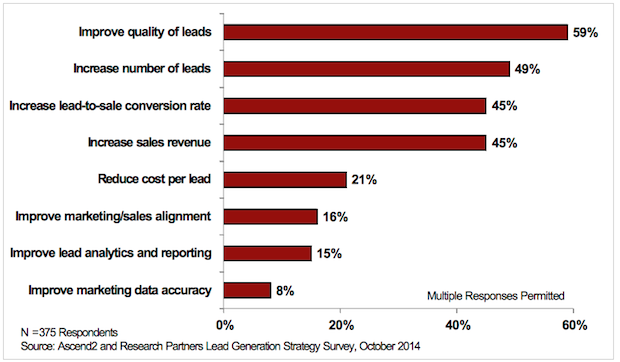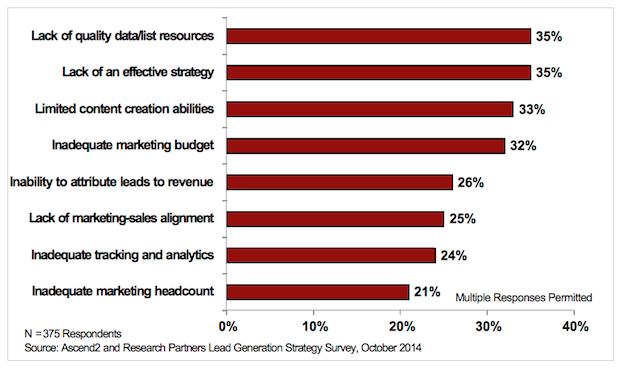Marketers want to provide their sales teams with hot, qualified leads so they can spend more time selling. Generating qualified leads fuels the sales pipeline, but prospects are becoming much more sophisticated about engaging with companies and sharing the information that marketers need to generate demand.
The Next Level of Lead Generation
In October 2014, Ascend2 fielded its Lead Generation Strategy Survey and completed interviews with 375 marketing, sales, and business professionals from around the world. In conducting this survey, Ascend2 hoped to determine how marketers can reach the next level of lead generation in the coming year. Of the marketers that participated in this survey, lead quality was the top objective for the coming year, followed by increasing the number of leads.

Figure 1: What are the most important objectives for your company’s lead generation strategy in the year ahead?
This study also determined that companies were more likely to rate their lead generation strategy as not successful rather than very successful.

Figure 2: How would you rate the success of your company’s lead generation strategy?
Contrary to popular belief, the most challenging obstacle to success is not budget. It is the lack of quality list data and the lack of an effective lead generation strategy.

Figure 3: What do you consider to be the most challenging obstacles to lead generation success?
Meeting the Lead Generation Challenge
As service providers explore strategies for success in 2015, helping marketing executives generate and nurture qualified leads should be a primary area of focus. We live in an interesting time for lead-generation marketing. With e-commerce and self-service sales, some companies don’t even need a sales force. They just need very effective lead generation marketing to help bring customers to them. This is a powerful paradigm shift, but service providers can still make a difference by adopting the following strategies:
Make sure that your client has well-defined goals. Many marketers start their lead generation campaigns with no specific goals in mind. They jump into the campaign without determining how many leads they want to bring in, or how cost-effective they need to be. When it’s over, they have no idea if their lead generation efforts have worked, or even if they’ve achieved a positive ROI for their company. Service providers in today’s market must ensure that their clients have well-articulated and clearly-defined objectives.
Understand your customers’ target markets. The most successful marketing service providers are strategic. They work with marketing executives to understand target markets and develop lead profiles. Establishing a lead profile involves determining exactly who fits into the ideal buyer image, and zeroing in on that target. The qualification criterion might include target industry, number of employees, revenue, location, and other information that is freely available about the lead.
Assess the best channel for communication. There are a number of options for generating leads, but there is no one magic answer. Service providers must work with clients to determine the marketing channels that will work best for them based on campaign objectives. Options include:
- Social media advertising (Facebook, LinkedIn, Twitter)
- Display advertising (a.k.a. banner ads)
- E-mail marketing
- Direct mail advertising
- Cold calling
- Trade shows
- Search engine marketing
Augment/analyze data. Successful service providers are offering database enhancement services to append missing information to customer databases. Providers are delivering an array of services ranging from business e-mail appends to custom list building and database validation to be at the forefront of list augmentation. 2015 may be the year to partner or invest in data analytics and predictive modeling tools. To properly service marketers, savvy providers must evaluate how to deliver predictive analytics and business intelligence to improve performance for sales and marketing. There are a number of desktop, client-server, big data analytics, and Cloud solutions available that can help turn information into actionable business decisions and a competitive advantage.
Personalize. Regardless of the communications channel, today’s technology means that you can help your customers personalize. The tools are available, and you can help marketers address prospects by name and offer a message that is designed to influence their specific buying needs and demographics.
Develop content for different stages in the buying process. As customers move through the buying cycle, seek opportunities to help the marketer create value for the prospect. When you’re developing content and landing page strategies, work with marketers to plan different designs based on the various stages of the customer buying process. Use personas that align to particular needs during each stage of that process, and develop the most appropriate offers and calls-to-action.
Measure, monitor, and adjust. With today’s technology, you can work with marketers on flexible and testable campaign strategies. Marketers can change the messaging to determine which headline, artwork, and promotional offer pulls the best results, and you can try a variety of formats, from e-mail to mobile to postcards to letters to brochures. With the right pre-planning, you can verify the success of every campaign and more easily ascertain the return on investment (ROI) based on calls to a toll-free tracking number, returned postcards, specific views of a webpage URL, or opt-ins to mobile sites.
Continue to market after the sale is completed. Work with marketing executives to maintain the relationship after the sale. The most successful marketers focus on existing customers because they know that it’s less expensive to keep an existing customer than to acquire a new one. Using an optimized range of activities and tactics, service providers can effectively maintain customer loyalty and expand the relationship to the next revenue milestone, be it service renewal, upgrade, or new purchase.
The Bottom Line
Marketing is assuming an increased responsibility for the actual process of lead generation, as well as for ensuring that a qualified lead is properly followed and measured. To be successful, marketers must treat potential customers as unique individuals. They need to help salespeople identify the best prospects and nurture those prospects throughout the sales cycle. Communications must be timely, and they should consider the following questions:
How does the prospect work?
What are their needs?
Where do they go for research?
Who in fact are they?
Print service providers must work with marketing executives to determine where the prospect is in the buying process, then select the appropriate communication tactics. Messaging and content must be targeted as appropriate. The right value proposition needs to be delivered via the correct tactics on a consistent basis. As we move into 2015, the most successful service providers will evaluate the processes and procedures that they have in place to help effectively manage the lead generation process and measure ROI and revenue contribution.










Discussion
Join the discussion Sign In or Become a Member, doing so is simple and free